Fatigue response and AE characteristics of soft and hard composite rock containing coplanar double joints
IF 5.7
2区 材料科学
Q1 ENGINEERING, MECHANICAL
引用次数: 0
Abstract
Jointed soft-hard composite rock masses are commonly encountered in engineering rock formations. The excavation-induced can lead to incompatible deformations between joints and soft-hard layers, resulting in more complex failure mechanisms compared to those under static loading. It is necessary to monitor rock micro-fracture events in real time during excavation to obtain the precursor information of rock instability. Therefore, this study conducted uniaxial compression, cyclic loading tests, and acoustic emission monitoring utilising coplanar double-jointed soft-hard composite rock masses. The fatigue characteristics of coplanar double-jointed soft-hard composite rocks were analyzed from the perspectives of strength, deformation, energy, and damage. The timing characteristics of tensile and shear signals for specimens with various joint inclinations were analyzed employing acoustic emission (AE) technology. Additionally, an early warning mechanism for rock instability based on AE multi-parameters was proposed. The results reveal that the fatigue life and limit energy storage coefficient are the lowest for the specimen with a 45° joint inclination. However, the minimum values of failure stress and failure strain occur in the specimen with a 30° inclination. During the fatigue tests, the energy density of the specimens increases in a stepwise way with the number of cycles. In addition, there is a quadratic polynomial relationship between each energy density and the upper stress limit. The realtime tensile signals of specimens exceed 60% at each stage of cyclic loading. By analyzing the variance and autocorrelation coefficient of AE parameters, it is revealed that the precursor points of failure extracted from the variance curves of peak frequency and signal intensity are closest to the final failure point.
含共面双节理的软硬复合岩石疲劳响应及声发射特征
节理的软硬复合岩体是工程岩体中常见的一类岩体。开挖引起的节理与软硬层之间的不相容变形,使其破坏机制比静荷载作用下更为复杂。在开挖过程中对岩石微破裂事件进行实时监测是获取岩石失稳前兆信息的必要条件。因此,本研究利用共面双节理软硬复合岩体进行了单轴压缩、循环加载试验和声发射监测。从强度、变形、能量、损伤等方面分析了共面双节理软硬复合岩石的疲劳特性。采用声发射(AE)技术分析了不同节理倾角试件的拉伸和剪切信号的时序特征。提出了基于声发射多参数的岩石失稳预警机制。结果表明,当接头倾角为45°时,试件的疲劳寿命和极限蓄能系数最低;破坏应力和破坏应变的最小值出现在倾角为30°的试样上。在疲劳试验过程中,试件的能量密度随循环次数的增加而逐步增大。此外,各能量密度与应力上限之间存在二次多项式关系。在循环加载的各个阶段,试件的实时拉伸信号均超过60%。通过分析声发射参数的方差和自相关系数,发现从峰值频率和信号强度方差曲线中提取的故障前兆点最接近最终故障点。
本文章由计算机程序翻译,如有差异,请以英文原文为准。
求助全文
约1分钟内获得全文
求助全文
来源期刊

International Journal of Fatigue
工程技术-材料科学:综合
CiteScore
10.70
自引率
21.70%
发文量
619
审稿时长
58 days
期刊介绍:
Typical subjects discussed in International Journal of Fatigue address:
Novel fatigue testing and characterization methods (new kinds of fatigue tests, critical evaluation of existing methods, in situ measurement of fatigue degradation, non-contact field measurements)
Multiaxial fatigue and complex loading effects of materials and structures, exploring state-of-the-art concepts in degradation under cyclic loading
Fatigue in the very high cycle regime, including failure mode transitions from surface to subsurface, effects of surface treatment, processing, and loading conditions
Modeling (including degradation processes and related driving forces, multiscale/multi-resolution methods, computational hierarchical and concurrent methods for coupled component and material responses, novel methods for notch root analysis, fracture mechanics, damage mechanics, crack growth kinetics, life prediction and durability, and prediction of stochastic fatigue behavior reflecting microstructure and service conditions)
Models for early stages of fatigue crack formation and growth that explicitly consider microstructure and relevant materials science aspects
Understanding the influence or manufacturing and processing route on fatigue degradation, and embedding this understanding in more predictive schemes for mitigation and design against fatigue
Prognosis and damage state awareness (including sensors, monitoring, methodology, interactive control, accelerated methods, data interpretation)
Applications of technologies associated with fatigue and their implications for structural integrity and reliability. This includes issues related to design, operation and maintenance, i.e., life cycle engineering
Smart materials and structures that can sense and mitigate fatigue degradation
Fatigue of devices and structures at small scales, including effects of process route and surfaces/interfaces.
 求助内容:
求助内容: 应助结果提醒方式:
应助结果提醒方式:


